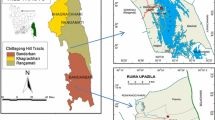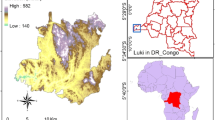Abstract
Most Nepalese rural households adopt diversified strategies of income generation and use products directly collected from forests. To analyse the influence of livelihood strategy on forest product utilisation, a survey of 336 rural households in lowland Nepal was conducted. Four livelihood strategies were identified by means of a Principal Component Analysis based on income variables, followed by hierarchical cluster analysis. Two livelihood strategies are assigned to on-farm activities and two to off-farm activities. The off-farm based strategies were found to result in higher household incomes. To test for differences across the livelihood strategies, additional socio-demographic variables, physical assets and location information have been analysed using ANOVA. The forest product utilisation behaviour of the households differs significantly between livelihood strategies. The households adopting a subsistence-based strategy collect the most forest products while achieving the lowest total income. However, a general influence of the total household income on the forest utilisation intensity is not confirmed. Households receiving remittances from abroad achieve the highest incomes but still collect forest products. The group of most forest-dependent households is mainly characterised by living near the forest and far from city centres with commodity and labour markets, and by having low education and a young head of household. The households relying mainly on private business income have the lowest forest product utilisation and are characterised by the highest education, proximity to markets and greatest area of agricultural land.
Similar content being viewed by others
References
Adhikari B, Di Falco S, Lovett JC (2004) Household characteristics and forest dependency: evidence from common property forest management in Nepal. Ecol Econ 48(2):245–257
Angelsen A, Wunder S (2003) Exploring the forest‐poverty link: key concepts, issues and research implications. http:/www.cifor.org/online-library/browse/view-publication/publication/1211.html. Accessed 15 Dec 2015
Barrett CB, Reardon T, Webb P (2001) Nonfarm income diversification and household livelihood strategies in rural Africa: concepts, dynamics, and policy implications. Food Policy 26(4):315–331
Brown K, Pearce DW (eds) (1994) The causes of tropical deforestation: the economic and statistical analysis of factors giving rise to the loss of the tropical forests. University College London Press, Vancouver
Budhathoki P (2003) Nepal’s conservation in crisis: empowering people to secure natural resources. J For Livelihood 2(2):72–76
Caplow S, Jagger P, Lawlor K, Sills E (2011) Evaluating land use and livelihood impacts of early forest carbon projects: lessons for learning about REDD+. Environ Sci Policy 14(2):152–167
Chambers R, Conway G (1991) Sustainable rural livelihoods: Practical concepts for the 21st century. IDS Discussion Paper 296. http://opendocs.ids.ac.uk/opendocs/bitstream/handle/123456789/775/Dp296.pdf?sequence=1. Accessed 13 May 2016
CIA (2012) The world factbook—Nepal. https://www.cia.gov/library/publications/the-world-factbook/geos/np.html. Accessed 17 Jan 2014
Colfer CJP, Byron Y (2001) People managing forests: the links between human well-being and sustainability. Resources for the future. CIFOR, Washington
Davidar P, Sahoo S, Mammen PC, Acharya P, Puyravaud J, Arjunan M, Garrigues JP, Roessingh K (2010) Assessing the extent and causes of forest degradation in India: where do we stand? Biol Conserv 143(12):2937–2944
Deng X, Huang J, Uchida E, Rozelle S, Gibson J (2011) Pressure cookers or pressure valves: do roads lead to deforestation in China? J Environ Econ Manag 61(1):79–94
Devkota RR (2010) Interests and power as drivers in community forestry: a case study of Nepal. Universitätsverlag Göttingen c/o SUB, Göttingen
Dhakal M, Masuda M (2009) Local pricing system of forest products and its relations to equitable benefit sharing and livelihood improvement in the lowland community forestry program in Nepal. For Policy Econ 11(4):221–229
Douglas I (2006) The local drivers of land degradation in south-east asia. Geogr Res 44(2):123–134
Ellis F (1999) Rural livelihood diversity in developing countries: Evidence and policy implications. https://www.odi.org/sites/odi.org.uk/files/odi-assets/publications-opinion-files/2881.pdf. Accessed 13 May 2016
FAO (2000) FRA 2000. Forest resources of Nepal, country report, Forest Resource Assessment Working Paper 16. Food and Agriculture Organization of the United Nations, Rome
FAO (2011) Guidelines for the preparation of livestock sector reviews. Animal Production and Health Guidelines 5. Rome. Food and Agriculture Organization of the United Nations, Rome. http://www.fao.org/docrep/014/i2294e/i2294e00.pdf. Accessed 22 Feb 2015
FAO (2016) Global forest resources assessment 2015—how are the world’s forests changing?, 2nd edn. Food and Agriculture Organization of the United Nations, Rome
FRISP (1999) Forest resources of Nepal (1987–1998). Department of forest research and survey, government of Nepal and forest resource information system project
GoN (2011) Nepal living standards survey 2010/2011: statistical report volume two. Government of Nepal (GoN), Central Bureau of Statistics
Gustafsson L, Nasi R, Dennis R, Nghia NH, Sheil D, Meijaard E, Dykstra D, Priyadi H, Thu PQ (2007) Logging for the ark: improving the conservation value of production forests in South East Asia. CIFOR Occasional Paper: 74p. http:/www.cifor.org/online-library/browse/view-publication/publication/2301.html. Accessed 5 Nov 2015
Hall R (2013) REDD + and the Underlying Causes of Deforestation and Forest Degradation. http://globalforestcoalition.org/wp-content/uploads/2013/11/REDD-and-UC-report-final.pdf. Accessed 22 Jan 2014
Halliday TJ (2012) Intra-household labor supply, migration, and subsistence constraints in a risky environment: evidence from rural El salvador. Eur Econ Rev 56(6):1001–1019
Illukpitiya P, Yanagida JF (2010) Farming vs forests: trade-off between agriculture and the extraction of non-timber forest products. Ecol Econ 69(10):1952–1963
ILO (2011) Decent work country programme for Nepal 2008–12. International labour organisation. http://www.ilo.org/public/english/bureau/program/dwcp/countries/index.htm. Accessed 18 Feb 2015
Iversen V, Chhetry B, Francis P, Gurung M, Kafle G, Pain A, Seeley J (2006) High value forests, hidden economies and elite capture: evidence from forest user groups in Nepal’s Terai. Ecol Econ 58(1):93–107
Kaimowitz D (2003) Forest law enforcement and rural livelihoods. Int For Rev 5(3):199–210
Kanel KR, Shrestha K (2001) Tropical secondary forests in Nepal and their importance to local people. J Trop For Sci 13(4):691–704
Kissinger GM, Herold VDS (2012) Drivers of deforestation and forest degradation: a synthesis report for REDD + policymakers. https://www.gov.uk/government/uploads/system/uploads/attachment_data/file/65505/6316-drivers-deforestation-report.pdf. Accessed 6 March 2014
Lanjouw P, Ravallion M (1994) Poverty and household size. Policy Research Working Paper 1332
Larsen HO, Olsen CS, Boon TE (2000) The non-timber forest policy process in Nepal: actors, objectives and power. For Policy Econ 1(3–4):267–281
MFSC (1995) Forest Act 2049 (1993) (official translation), Ministry of forest and soil conservation (MFSC), Government of Nepal. Translated by law books management board/HMGN, 22 May 1995
MFSC (2016) National Forest Reference Level of Nepal (2000–2010). Ministry of Forest and Soil Conservation (MFSC), Government of Nepal, Kathmandu, Nepal. redd.unfccc.int/files/Nepal_frl_jan_8__2017.pdf. Accessed 20 Jan 2017
Ojha H (2009) Community forestry in Nepal: a policy innovation for local livelihoods. International Food Policy Research Institute, Pokhara
Orbeta AC (2005) Empirical overview of the relationships of family size, poverty and vulnerability to poverty: research paper series no. 68
Parker P, Thapa B, Jacob A (2015) Decentralizing conservation and diversifying livelihoods within Kanchenjunga Conservation Area, Nepal. J Environ Manag 164:96–103
Pokharel RK (2008) Pro-poor programs of Nepals community forestry. Who benefits? presented at the international association for the study of commons 12th biennial conference, 14–18 July 2008. University of Gloucestershire
Purnamasari R (2010) Dynamics of small-scale deforestation in Dynamics of small-scale deforestation in Indonesia: examining the effects of poverty and socio-economic development and socio-economic development. Forests and Biodiversity. Unasylva No. 234/235, 6:14–20
Ratha D, Mohapatra S (2013) Migrant remittances and development. In: Caprio G (ed) The evidence and impact of financial globalization, vol 8. Academic Press, San Diego, pp 121–130
Rayamajhi S, Smith-Hall C, Helles F (2012) Empirical evidence of the economic importance of Central Himalayan forests to rural households. For Policy Econ 20:25–35
Reddy SRC, Chakravarty SP (1999) Forest dependence and income distribution in a subsistence economy: evidence from India. World Dev 27(7):1141–1149
Regmi B, Garforth C (2010) Trees outside forests and rural livelihoods: a study of Chitwan District, Nepal. Agrofor Syst 79(3):393–407
Sapkota IP, Odén PC (2008) Household characteristics and dependency on community forests in Terai of Nepal. Int J Soc For 1(2):123–144
Scoones I (1998) Sustainable rural livelihoods: a framework for analysis: IDS working paper 72. http://www.ids.ac.uk/publication/sustainable-rural-livelihoods-a-framework-for-analysis. Accessed 7 Feb 2014
Subedi G, Khatiwada B, Bhattarai S, Acharya KP (2009) Forest composition, fuelwood harvest and regeneration status in four community forests of central Nepal. Sci World 7(7):53–58
Tuladhar R, Sapkota C, Adhikari N (2014) Effects of migration and remittance income on Nepal’s agriculture yield. South Asia Working Paper Series 27
UN (1992a) Convention on biological diversity, United Nations
UN (1992b) United Nations framework convention on climate change, United Nations
UNCSD (2012) A/CONF.216/16—Report of the United Nations conference on sustainable development, New York
Vedeld P, Angelsen A, Bojö J, Sjaastad E, Kobugabe Berg G (2007) Forest environmental incomes and the rural poor. Econ Perspect Anal Mult For Values Sustain For Manag 9(7):869–879
Virola RA, Martinez AM (2007) Population and poverty nexus: does family size matter? 10th national convention on statistics (NCS), Manila
Ward JH Jr (1963) Hierarchical grouping to optimize an objective function. J Am Stat Assoc 58(301):236–244
World Bank (2011) Poverty and equity: country dashboard Nepal. http://povertydata.worldbank.org/poverty/country/NPL. Accessed 15 Dec 2015
Acknowledgements
The study was conducted as part of the project “Approaches for the Improvement of the Economic Sustainability of Forest Management in the Tropics” carried out by the Thünen-Institute for World Forestry, funded by the German Federal Ministry of Food and Agriculture. We would like to express our gratitude for the great support for our fieldwork by Prem Neupane, the Department of Forests, the Department of National Parks and Wildlife Conservation, the University of Pokhara, the District Forest Office Chitwan, Jogesh, Salina, Sudip, Bishnu, and the survey respondents for their participation. We thank Prof. Dr. Dieter and assistant lecturer Dr. Günter from the Thünen-Institute and Prof. Dr. Köhl from the University of Hamburg for helpful discussions. The responsibility for any remaining errors remains by the authors.
Author information
Authors and Affiliations
Corresponding author
Rights and permissions
About this article
Cite this article
Lax, J., Köthke, M. Livelihood Strategies and Forest Product Utilisation of Rural Households in Nepal. Small-scale Forestry 16, 505–520 (2017). https://doi.org/10.1007/s11842-017-9367-0
Accepted:
Published:
Issue Date:
DOI: https://doi.org/10.1007/s11842-017-9367-0




